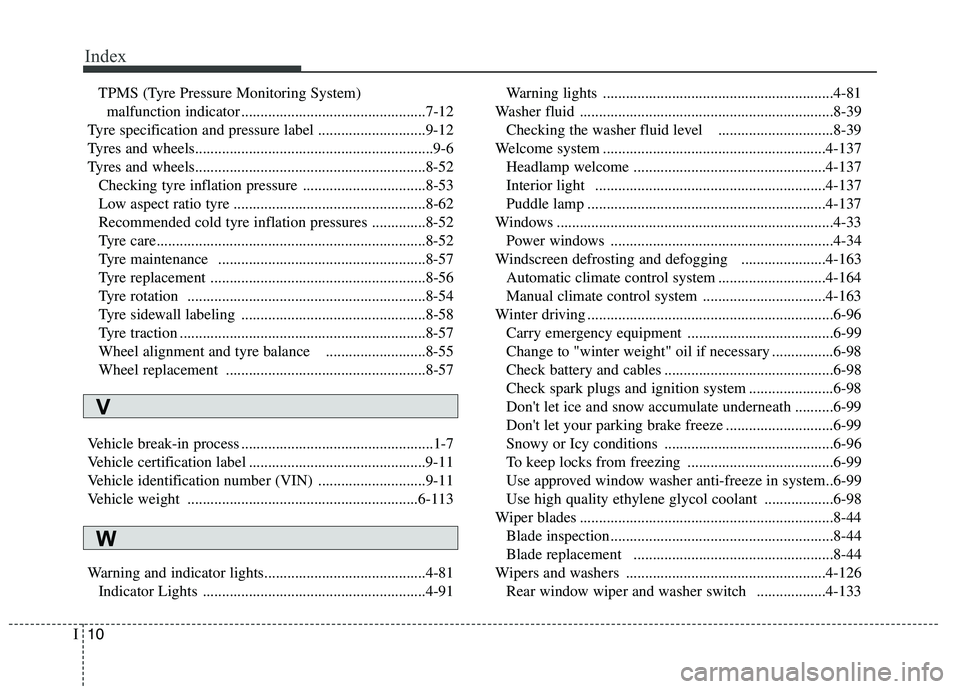2017 KIA CARENS RHD coolant
[x] Cancel search: coolantPage 696 of 723

8109
Maintenance
EMISSION CONTROL SYSTEM
The emission control system of your
vehicle is covered by a written limited
warranty. Please see the warranty
information contained in the Service
Passport in your vehicle.
Your vehicle is equipped with an emission control system to meet all
emission regulations. There are three emission control
systems which are as follows.
(1) Crankcase emission control sys- tem
(2) Evaporative emission control sys- tem
(3) Exhaust emission control systemIn order to assure the proper function
of the emission control systems, it is
recommended that you have your
car inspected and maintained by an
authorised Kia dealer in accordance
with the maintenance schedule. Caution for the Inspection and
Maintenance Test (With Electronic
Stability Control (ESC) system)
To prevent the vehicle from mis-
firing during dynamometer test-
ing, turn the Electronic Stability
Control (ESC) system off by
pressing the ESC switch.
After dynamometer testing is completed, turn the ESC system
back on by pressing the ESC
switch again.
1. Crankcase emission control system
The positive crankcase ventilation
system is employed to prevent air
pollution caused by blow-by gases
being emitted from the crankcase.This system supplies fresh filtered air
to the crankcase through the air
intake hose. Inside the crankcase,
the fresh air mixes with blow-by
gases, which then pass through the
PCV valve into the induction system. 2. Evaporative emission con-
trol System
The Evaporative Emission Control
System is designed to prevent fuel
vapours from escaping into the
atmosphere.
Canister
Fuel vapours generated inside the fuel tank are absorbed and stored in
the onboard canister. When the
engine is running, the fuel vapours
absorbed in the canister are drawninto the surge tank through the purge
control solenoid valve.
Purge Control Solenoid Valve (PCSV)
The purge control solenoid valve is
controlled by the Engine Control
Module (ECM); when the engine
coolant temperature is low during
idling, the PCSV closes so that evap-
orated fuel is not taken into the
engine. After the engine warms-up
during ordinary driving, the PCSV
opens to introduce evaporated fuel to
the engine.
Page 708 of 723

99
Specifications & Consumer information
Lubricant Volume Classification
Coolant
Petrol Engine
1.6LM/T6.2l(6.6US qt.)
Mixture of antifreeze and distilled water
(Ethylene glycol base coolant for aluminum radiator)A/T6.0l(6.3US qt.)
2.0LM/T6.3 l(6.7US qt.)
A/T6.0 l(6.3US qt.)
Diesel
EngineM/T7.0 l~ 7.1 l
DCT7.0l~ 7.1 l
Brake/clutch fluid0.7~0.8 l
(0.7~0.8 US qt.)FMVSS116 DOT-3 or DOT-4
Fuel 58 l (15.3 US gal.) Refer to “Fuel requirements” in chapter 1
*1
Refer to the recommended SAE viscosity numbers on the next page.
* 2
Engine oils labeled Energy Conserving Oil are now available. Along with other additional benefits, they contribute to fuel economy by reducing
the amount of fuel necessary to overcome engine friction. Often, these improvements are difficult to measure in everyday driving, but in a year’s
time, they can offer significant cost and energy savings.
* 3
Diesel Particulate Filter
* 4
If you replace the engine oil, we recommend to contact a Kia workshop or equally qualified workshop.
M/T: Manual transaxle
A/T: Automatic transaxle
Recommends Engine Oil (For Europe)
SupplierDiesel Engine
ShellHELIX ULTRA AP 5W-30
HELIX ULTRA AP-L 5W-30
Page 716 of 723

Index
4
I
To cancel cruise control ..............................................6-67
To decrease the cruising speed ..................................6-66
To increase cruise control set speed ..........................6-66
To resume cruising speed at more than approximately 30 km/h (20 mph) ............................6-68
To set cruise control speed..........................................6-65
To temporarily accelerate with the cruise control on ....6-67
To turn cruise control off ............................................6-68
Declaration of conformity ............................................9-13
Defroster ......................................................................4-138 Rear window defroster ..............................................4-138
Dimensions ......................................................................9-2
Door locks......................................................................4-23 Child-protector rear door lock ....................................4-29
Deadlocks....................................................................4-27
Door lock/unlock features ..........................................4-28
Operating door locks from inside the vehicle ............4-24
Operating door locks from outside the vehicle ........4-23
Dual Clutch Transmission (DCT) ................................6-34 Dual clutch transmission operation ..........................6-34
Good driving practices ................................................6-41
Economical operation ....................................................6-90 Emergency Commodity ................................................7-37
Fire extinguisher ........................................................7-37
Triangle reflector ......................................................7-37
Emergency starting ..........................................................7-5 Jump starting ..............................................................7-5
Push-starting ..............................................................7-7
Emission control system ..............................................8-109 Crankcase emission control system ..........................8-109
Evaporative emission control System ......................8-109
Exhaust emission control system ..............................8-110
Lean NOx Trap ........................................................8-112
Engine ..............................................................................9-2
Engine compartment ................................................2-6, 8-3
Engine coolant ..............................................................8-34 Changing the coolant ..................................................8-37
Checking the coolant level ....................................8-34
Engine number ..............................................................9-12
Engine oil ......................................................................8-32 Changing the engine oil and filter ..............................8-33
Checking the engine oil level ....................................8-32
ENGINE START/STOP button ....................................6-10 Engine start/stop button position ................................6-10
Illuminated engine start/stop button ..........................6-10
Starting the engine ......................................................6-13
Explanation of scheduled maintenance items ..............8-28
Exterior features ..........................................................4-186 Roof rack ..................................................................4-186
Exterior overview ............................................................2-2
D
E
Page 722 of 723

Index
10
I
TPMS (Tyre Pressure Monitoring System)
malfunction indicator ................................................7-12
Tyre specification and pressure label ............................9-12
Tyres and wheels..............................................................9-6
Tyres and wheels............................................................8-52 Checking tyre inflation pressure ................................8-53
Low aspect ratio tyre ..................................................8-62
Recommended cold tyre inflation pressures ..............8-52
Tyre care......................................................................8-52
Tyre maintenance ......................................................8-57
Tyre replacement ........................................................8-56
Tyre rotation ..............................................................8-54
Tyre sidewall labeling ................................................8-58
Tyre traction ................................................................8-57
Wheel alignment and tyre balance ..........................8-55
Wheel replacement ....................................................8-57
Vehicle break-in process ..................................................1-7
Vehicle certification label ..............................................9-11
Vehicle identification number (VIN) ............................9-11
Vehicle weight ............................................................6-113
Warning and indicator lights..........................................4-81 Indicator Lights ..........................................................4-91 Warning lights ............................................................4-81
Washer fluid ..................................................................8-39 Checking the washer fluid level ..............................8-39
Welcome system ..........................................................4-137 Headlamp welcome ..................................................4-137
Interior light ............................................................4-137
Puddle lamp ..............................................................4-137
Windows ........................................................................4-33 Power windows ..........................................................4-34
Windscreen defrosting and defogging ......................4-163 Automatic climate control system ............................4-164
Manual climate control system ................................4-163
Winter driving ................................................................6-96 Carry emergency equipment ......................................6-99
Change to "winter weight" oil if necessary ................6-98
Check battery and cables ............................................6-98
Check spark plugs and ignition system ......................6-98
Don't let ice and snow accumulate underneath ..........6-99
Don't let your parking brake freeze ............................6-99
Snowy or Icy conditions ............................................6-96
To keep locks from freezing ......................................6-99
Use approved window washer anti-freeze in system..6-99
Use high quality ethylene glycol coolant ..................6-98
Wiper blades ..................................................................8-44 Blade inspection ..........................................................8-44
Blade replacement ....................................................8-44
Wipers and washers ....................................................4-126 Rear window wiper and washer switch ..................4-133
V
W